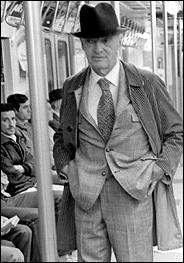-
|

|
Chapter 10: Late Twentieth Century and Postmodernism
Saul Bellow
1915-2005
|
©
Paul Reuben
September 15, 2019
E-Mail
|
Page Links: |
Primary
Works |
Selected
Bibliography 2000-Present
| Study
Questions |
MLA Style
Citation of this Web Page
|
Site
Links: | Chap. 10: Index | Alphabetical
List
| Table
Of Contents
| Home
Page
|

Source: NY
Times Obituary April 6, 2005
Primary
Works
Dangling
man. NY: Vanguard P, 1944. PS3503.E4488 D3
The Victim. NY:
Vanguard P, 1947. PS3503.E4488 .V5
The Adventures of
Augie March, 1953.
Seize the Day,
1956.
Henderson, the rain
king; a novel. NY: Viking P, 1959. PS3503.E4488 .H4
Herzog,
1964.
The last analysis.
NY: Viking P, 1965. PS3503.E4488 L3
The Arts & the
public. Essays by Saul Bellow and others. Edited by James E.
Miller, Jr. and Paul D. Herring. Chicago: U of Chicago P, 1967
PS688 .A7
Mosby's memoirs and
other stories. NY: Viking P, 1968. PS3503.E4488 M6
Mr. Sammler's
planet. NY: Viking P, 1970. PS3503.E4488 .M4
Technology and the
frontiers of knowledge. Foreword: Daniel J. Boorstin.
Contributors Saul Bellow and others. The Frank Nelson Doubleday
lectures; 1972 73. T185 T38
Humboldt's gift.
NY: Viking P, 1975. PS3503.E4488 H8
To Jerusalem and back:
a personal account. NY: Viking P, 1976. DS107.4 B37
The dean's December: a
novel. NY: Harper & Row, 1982. PS3503.E4488 D4
Him with his foot in
his mouth and other stories. NY: Harper & Row, 1984.
PS3503 .E4488 H56
More die of
heartbreak. NY: Morrow, 1987. PS3503 .E4488 M5
A theft: a
novella. NY: Penguin Books, 1989. PS 3503 .E4488 T4
The bellarosa
connection. NY: Penguin, 1989. PS3503 .E4488 B45
Something to Remember
Me By, 1991.
It all adds up: from
the dim past to the uncertain future: a nonfiction collection.
NY: Viking, 1994. PS3503 .E4488 O23
The actual. NY:
Viking, 1997. PS3503 .E4488 A63
Letters. edited by
Benjamin Taylor. Viking, 2010.
| Top
| Selected Bibliography 2000-Present
Assadi, Jamal. Acting,
Rhetoric, and Interpretation in Selected Novels by F. Scott
Fitzgerald and Saul Bellow. NY: Peter Lang, 2006.
Atlas, James. Bellow: A
Biography. NY: Random House, 2000.
Bellow, Greg. Saul
Bellow's Heart: A Son's Memoir. NY: Bloomsbury, 2013.
Chodat, Robert. Worldly
Acts and Sentient Things: The Persistence of Agency from Stein to
DeLillo. Ithaca, NY: Cornell UP, 2008.
Clements, James.
Mysticism and the Mid-Century Novel. NY: Palgrave Macmillan,
2012.
Codde, Philippe. The
Jewish American Novel. West Lafayette, IN: Purdue UP, 2007.
Halldorson, Stephanie S.
The Hero in Contemporary American Fiction: The Works of Saul
Bellow and Don DeLillo. NY: Continuum, 2007.
Margolies, Edward. New
York and the Literary Imagination: The City in Twentieth Century
Fiction and Drama. Jefferson, NC: McFarland, 2008.
Quayum, M. A. Saul Bellow
and American Transcendentalism. NY: Peter Lang, 2004.
Wirth-Nesher, Hana. Call
It English: The Languages of Jewish American Literature.
Princeton, NJ: Princeton UP, 2006.
Study
Questions
"Looking for Mr.
Green"
1. (a) What is the purpose
in the story of Grebe's supervisor Raynor? What is Bellow's attitude
toward Raynor's cynical "wisdom"? Is concern for the individual
anachronistic? For philosophical studies?
(b) What is the purpose of
the encounter with the Italian grocer who presents a hellish vision
of the city with its chaotic masses of suffering humanity?
(c) The old man Field offers
this view of money--"Nothing is black where it shines and the only
place you see black is where it ain't shining." Discuss. What do you
think of the scheme for creating black millionaires? Why does Bellow
include this scheme in the story?
(d) What is the purpose of
the Staika incident in the story? Raynor sees her as embodying "the
destructive force" that will "submerge everybody in time," including
"nations and governments." In contrast, Grebe sees her as "the life
force." Who is closer to the truth?
(e) The word "sun" and sun
imagery are repeated throughout the story. Discuss.
2. (a) Discuss the theme of
appearance versus reality.
(b) Bellow ends the story
with Grebe's encounter with the drunken, naked black woman, who may
be another embodi- ment of the spirit of Staika. Why does Bellow
conclude the story this way? Has Grebe failed or succeeded? Is he
deceiving himself?
(c) David Demarest comments:
"Grebe's stubborn idealism is nothing less than the basic human need
to construct the world according to intelligent, moral principles."
Discuss.
(d) Believing that "Looking
for Mr. Green" needs to be seen "as one of the great short stories of
our time," Eusebio Rodrigues argues that the Old Testament flavors
it. This story is "a modern dramatization of Ecclesiastes."
Discuss.
MLA Style
Citation of this Web Page
Reuben, Paul P.
"Chapter 10: Saul Bellow." PAL: Perspectives in American
Literature- A Research and Reference Guide.
URL: http://www.paulreuben.website/pal/chap10/bellow.html
(provide page date or date of your login).
| Top
|

